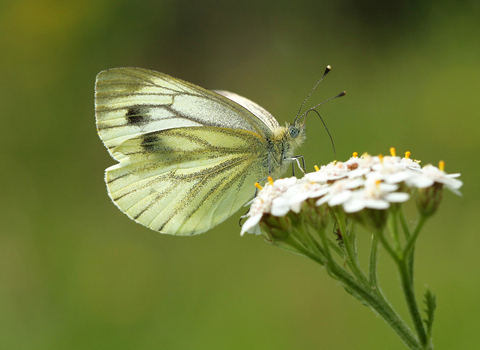
©Jon Hawkins
Green-veined white
The green-veined white is a common butterfly of hedgerows, woodlands, gardens and parks. It is similar to other white butterflies, but has prominent green stripes on the undersides of its wings.
Scientific name
Pieris napiWhen to see
April to OctoberSpecies information
Category
Statistics
Wingspan: 4.0-5.2cmCommon.
About
The green-veined white is a fairly small, white butterfly that is on the wing between April and October. A common butterfly, it is found in a wide variety of habitats, including hedgerows, woodland rides and meadows, as well as farmland, gardens and parks. It especially likes damp areas with lush vegetation. Water-cress is a very common host plant for the butterfly. The foodplants of the caterpillars are members of the cabbage family, including cuckooflower and hedge mustard.How to identify
The green-veined white is white with black wingtips and one or two black spots on the forewing. Smaller than the large white, it has less black in the wing. It can be distinguished from the very similar Small white by the thick, grey-green stripes along the veins on the undersides of its wings. It also tends to be found in damper habitats.Distribution
Widespread.Did you know?
The first brood of female green-veined whites lay their eggs in May on the caterpillars' foodplant. Two weeks later, the caterpillars emerge; they feed for up to a month, then pupate, emerging as second brood adults two weeks later. The eggs of this generation are laid in late summer and the pupae hibernate over winter, emerging as adults the following spring.Watch
Green-veined white (https://vimeo.com/473846270)
Green-veined white ©Tom Hibbert
